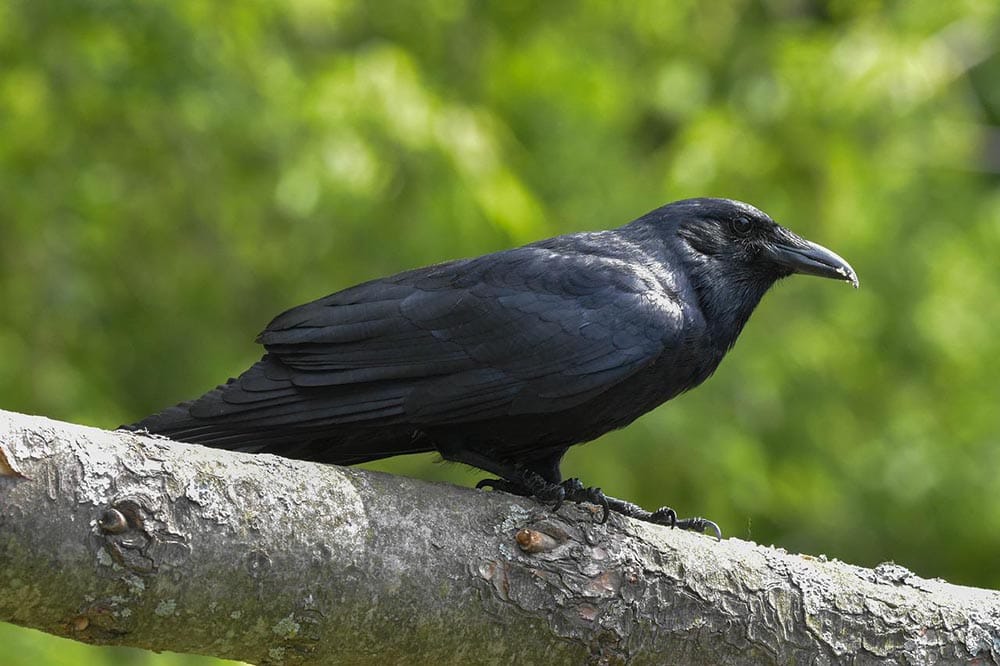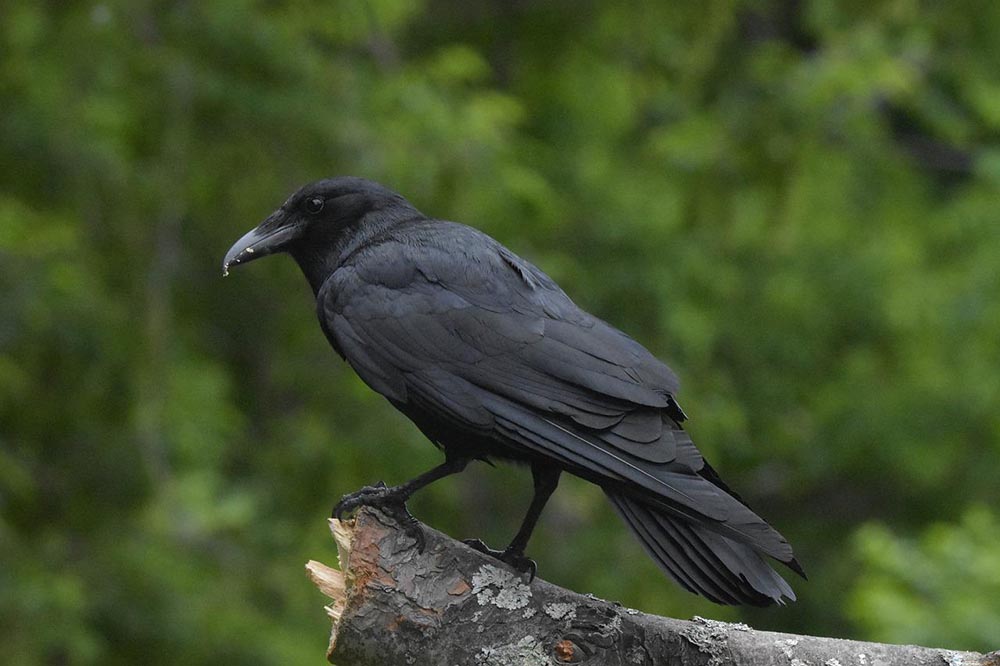American Crow: Field Guide, Pictures, Habitat & Info
Last Updated on

While the American crow probably isn’t what most people think of when you mention “favorite birds,” the more you dive into them, the more likable they become. They travel in familial units, are extremely intelligent, and can take over just about any landscape that humans modify.
If you’re living in the United States, the American crow is all around you, and that’s not likely to change any time soon.

Quick Facts About the American Crow
| Habitat: | Fields, open woodlands, forests, lawns, parking lots, roadsides, towns, garbage dumps, etc. |
| Diet: | Insects, spiders, snails, worms, frogs, carrion, garbage, eggs, seeds, grains, berries, fruits, etc. |
| Behavior: | Social and cooperative |
| Nesting: | Near the trunk of trees at the top third, shrubs, and other safe locations |
| Conservation: | Least Concern (IUCN) |
| Scientific name: | Corbus brachyrhynchos |
| Lifespan: | 7 to 8 years in the wild, up to 30 years in captivity |
American Crow General Description
While most people don’t give an American crow a second glance, they’re actually among the most intelligent birds in the United States¹.
They have an all-black appearance, from feathers to beak. The feathers might have a brownish hue at times, but that’s only when they’re getting ready to molt.
The American crow stays in flocks, which can sometimes number in the thousands.

American Crow Range, Habitat, Behavior, Diet & Nesting
Range
While Americans have grown accustomed to seeing American crows just about everywhere, they don’t have much of a range outside of North America.
They live year-round in most of the United States, and they never venture as far south as Mexico. They live along both coasts, and they’ll go to Canada for the breeding season. But otherwise, these birds live almost exclusively year-round in the United States.
Habitat
Before humans radically changed landscapes just about everywhere, a crow’s natural habitat was among fields, open woodlands, and forests. Due to the crow’s high intelligence and ability to adapt, their habitats have rapidly expanded to include areas with high human activity.
Today, you can still find crows in all their traditional habitats, but you can also find them just about anywhere there are humans. This includes both suburbs and urban centers, where crows have found ways to live and thrive among humans.
Behavior
You’re unlikely to find a bird that’s more social with other birds of their own species than the American crow. Not only do they travel in flocks, but they also generally stick to familial units. In fact, scientists have observed crows with familial units of up to three generations!
They live and work together, and it’s due to their high intelligence and cooperation that they’re able to outcompete many local birds.
Diet
While the American crow has a few favorite foods, they’ll chow down on just about anything that they can find. They eat insects, seeds, eggs of other birds, and even garbage.
They also eat carrion, grains, fruits, and snakes. They’re not picky eaters, and this has helped them flourish and thrive even in rapidly changing environments.
Nesting
While the American crow is versatile with their nesting habits when necessary, this is one area where they try their best not to mix things up.
They build their nests in the top third of well-established trees, as close to the trunk as possible. While they will build their nests in shrubs and other lower greenery, they prefer to keep their nests higher off the ground.


How to Find American Crows: Birdwatching Tips
What to Listen For
The American crow is technically a songbird, and they’re quite loud about it. They have a signature caw that can be aesthetically irritating to many people. Once you’ve heard an American crow caw, you won’t mistake the noise to be from any other bird.
What to Look For
If you’re trying to spot an American crow, all you need to do is head to a human-modified landscape, like a city park, campground, or garbage dump, and look up. They perch up high when they’re not eating, so they can survey an entire area.
When to Look
If you’re trying to spot a crow, your best bet is during the day. That’s when they’re most active, and their all-black appearance makes them nearly impossible to spot when the sun sets.
Attracting American Crows to Your Backyard: Tips & Tricks
If you’re trying to attract the American crow to your backyard, be careful what you wish for! These birds travel in flocks, so if you’re successful, you might have hundreds or even thousands of these visitors completely draining any feeders that you have out in a single day.
With that fair warning, here are a few things that you can do to attract American crows to your yard.
Put out feeders with large openings, and scatter plenty of the food around the base of the feeders. It doesn’t matter much what you put out, since crows will eat anything, but large seeds, like sunflower seeds, that other birds struggle to eat will be appreciated.
In short, keep food out and plentiful in a way that a large bird can eat it, and stock up when crows come to visit. Ultimately, the biggest deterrent will likely be that you can’t keep enough food stocked to keep hundreds or thousands of crows fed and happy.

American Crows Conservation: Is this Bird Threatened?
The IUCN lists the American crow under the category of “Least Concern.” Considering how well they adapt to life around humans and the fact that their population numbers are increasing, you don’t have to worry about missing American crows any time soon.
However, as the planet warms, it wouldn’t be surprising to see their range shift slightly north to follow the more temperate regions.

Conclusion
The American crow is a fixture across North America. Their population numbers are on the rise, and they thrive around humans, making them one of the most spotted birds in the region.
Just be careful if you’re trying to attract them to your yard because they arrive in force and will drive away just about any other bird.
Featured Image Credit: JackBulmer, Pixabay
Table of Contents
About the Author Robert Sparks
Robert’s obsession with all things optical started early in life, when his optician father would bring home prototypes for Robert to play with. Nowadays, Robert is dedicated to helping others find the right optics for their needs. His hobbies include astronomy, astrophysics, and model building. Originally from Newark, NJ, he resides in Santa Fe, New Mexico, where the nighttime skies are filled with glittering stars.
Related Articles:
10 Types of Hummingbirds in Arkansas (With Pictures)
8 Types of Hummingbirds in Nebraska (With Pictures)
5 Types of Hummingbirds in Idaho (With Pictures)
3 Types of Hummingbirds in Mississippi (With Pictures)
8 Types of Hummingbirds in Kansas (With Pictures)
5 Types of Hummingbirds in West Virginia (With Pictures)
5 Types of Hummingbirds in Ohio (With Pictures)
Where Do Nuthatches Nest? Nuthatch Nesting Habits Explained
